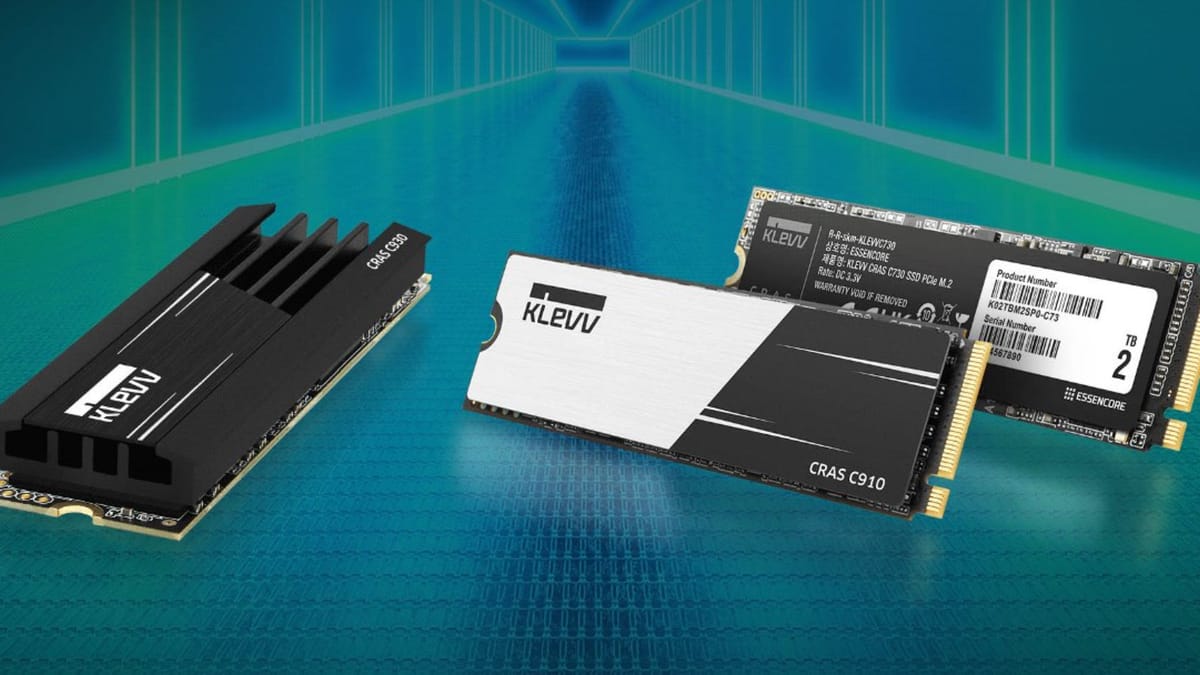
We review a lot of drives around here, but this is the first we’ve heard of KLEVV. A subsidiary of ESSENCORE, KLEVV is a semiconductor distributor from South Korea, which is itself owned by SK Hynix. They’ve been working in the flash-based drive space for a while now, having shipped more than a few SATA and portable SSDs, as well as their flagship CRAS C-series M.2 drives. In addition, they’ve shipped a number of USB drives, flash-based memory modules, and RAM for both the portable and desktop market. While they’ve only been around since 2014, they’ve quickly found their footing, shipping a lot of top-tier gear. I was eager to see if we had a new player in the hardware space.
Unboxing the C910 and the C930, both drives ship bare, but with an included aluminum heat sink with integrated thermal pad in the box. It’s a nice option that means you don’t have to worry about picking up the wrong SKU, or needing to order a third party cooling solution should your configuration change. What surprised me was just how thin the heat sink is – just 1mm thick. This means it could potentially fit underneath other components rather than butting up against a GPU. It also makes it perfect for small form factor devices like laptops or small form factor PCs where space is a concern. The C930’s heat sink is a bit beefier, but it also pulls 20% of the collected heat off the surface versus the 10% of the C910. In both cases, the packaging serves a dual purpose – it’s a guide to apply the heatsink. Leaving the bare stick in the package, you remove the thermal pad cover and align it directly in the package for a perfect fit. The C930’s heat sink is also small enough to fit cleanly inside the PlayStation 5, and it’s fast enough to pass the speed test necessary for that purpose.
A peek under the hood reveals an Innogrit IG5220 controller (Innogrit has powered devices from Plextor, VisionTek, and Viper to name a few) – one of the few controllers manufactured in the United States. In the case of the C910, it’s a DRAM-less low-power drive, with reported sequential reads in the 5000 MB/s and sequential writes around 4800 MB/s range, or roughly 830K Read IOPs and 670K Write IOPs. Since it is a PCIe Gen4x4 NVMe 1.4 drive, it also supports AES encryption of up to 256 bits, with Low Density Parity Check (LDPC) ECC protection for reliability. The C930 punches above that weight with a stated speed of 7400 MB/s read, 6400 MB/s write, and 1 million IOPs for 4K random read/writes.
We’ve tested DRAM-less SSDs in the past, and it’s very workload dependent on whether that actually matters to the results. Without DRAM, the system will have to hit the PCIe bus back to the CPU for the mapping tables for data locations instead of storing them locally in a small bit of cache memory. As such, it introduces a small bit of latency for random reads and writes, though sequential writes seem to suffer far less. Technologies like Host Memory Buffer (HMB) can borrow a bit of RAM for the same task, which is certainly faster, but not as fast as on-chip. Fortunately the C910 sports HMB, mitigating at least some of the latency of a DRAM-less drive. So what’s the advantage of the C910 over other drives? One thing: price. The C910 retails for $45.99 for 500GB, and $69.99 for 1TB, roughly 20% less than other similarly-specced drives, and easily half that of similar drives equipped with DRAM. The only way to see if that price difference is worth it is to bench it, so let’s do that.
As always, we run our benchmarks at least three times, and after a clean boot. We also work through real-world transfers to see what effect DRAM and other caching techniques have on performance. We use a variety of tools, but have found that CrystalDiskMark and ATTO are representative of max values as well as a full complement of various file sizes.
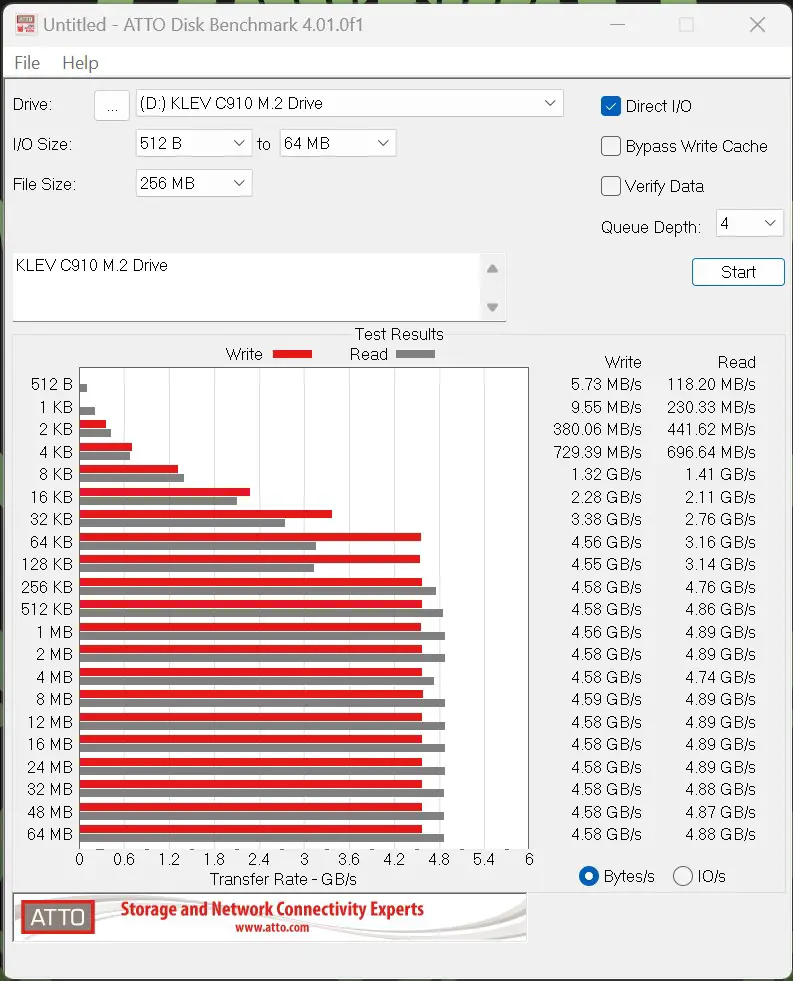
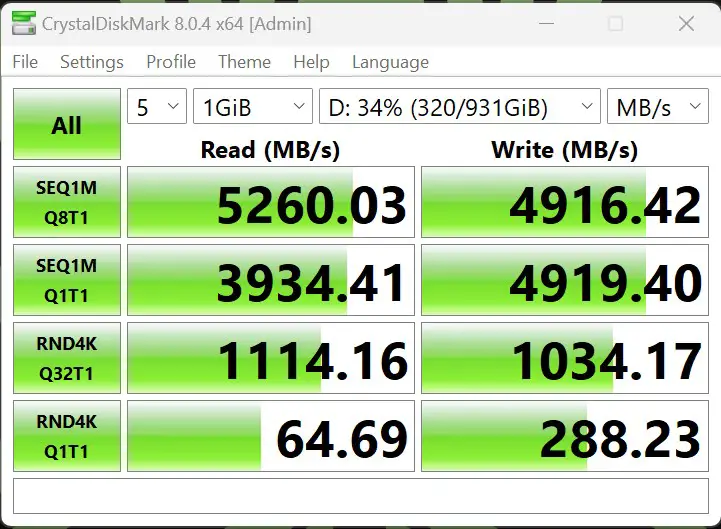
What I like about the C910 is that it is remarkably consistent. Across a wide variety of file sizes, the drive is able to deliver at the mechanical maximum. Surprisingly, the lack of DRAM cache is mostly compensated for by the Host Memory Buffer – something you’ll encounter when you are moving large blocks of sequential data, such as video files or large .dat payloads. Given the price difference between the C910 and the C930, I wanted to see not only the technological differences, but also how it impacts the overall performance.
The C930 uses the Innogrit IG5221 controller, which carries with it 8GB of 16-bit DDR SDRAM for cache. It’s also a PCIe Gen4x4 NVMe 1.4 drive, just like its smaller 910 brother, but it sports read speeds of 7400 MB/s and 6800 MB/s write speeds. Just like the C910, the only thing left to do is benchmark it to see if KLEVV can live up to those speed numbers.
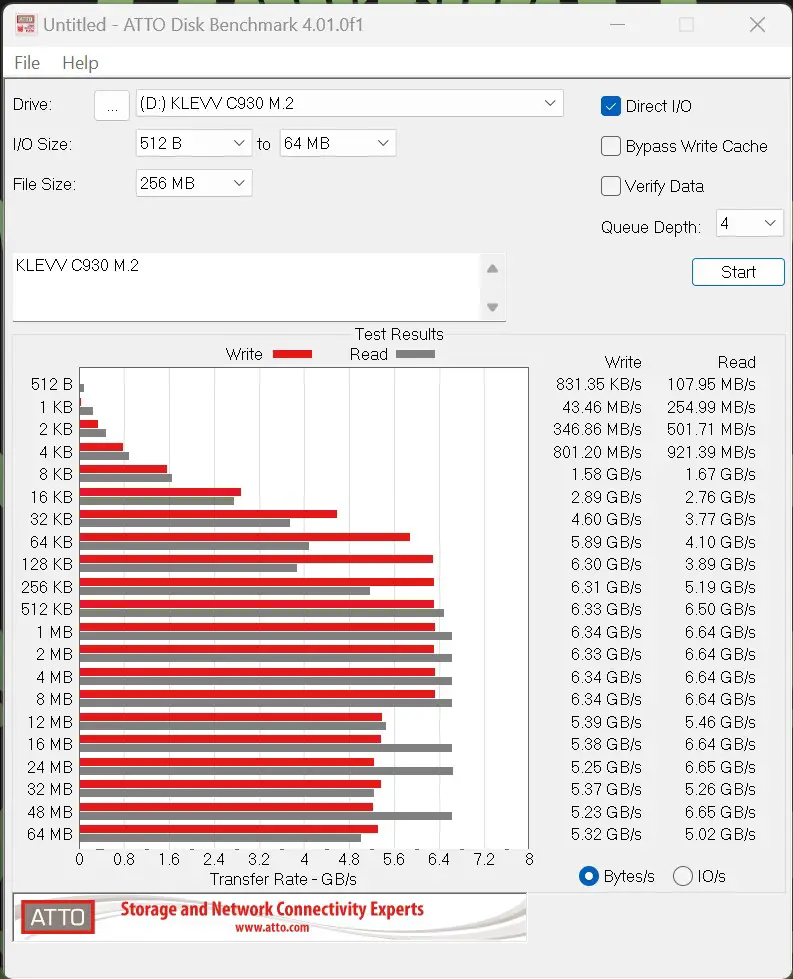
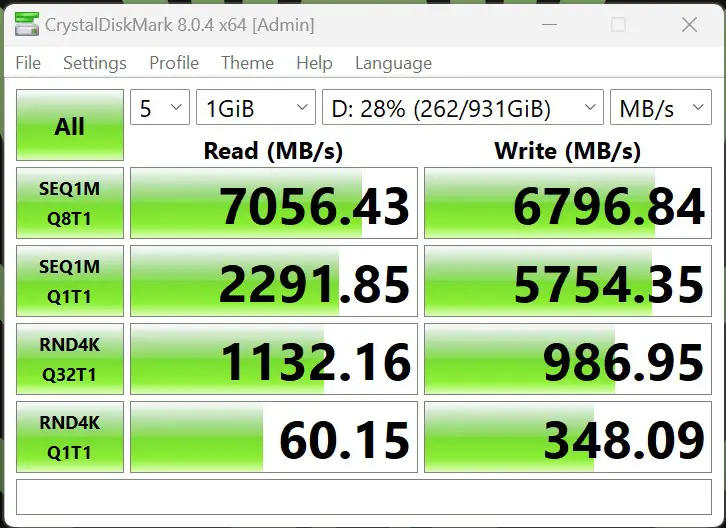
Once again we see the pure uncut raw power of the C930, though this time around we lose some of the consistency when the DRAM cache is exhausted at the end of the payload. Still, you can clearly see the drive delivering in the 6.65 GB/s range, even when having to make a longer roundtrip through the swap file or CPU. It’s impressive, but with that controller it’s not a surprise. Next up, I wanted to throw around some massive games and see how the C930 handled it. Programs tend to be a mixture of files both large, small, and everything in between, meaning the drive would be given the opportunity to throttle up and down multiple times.
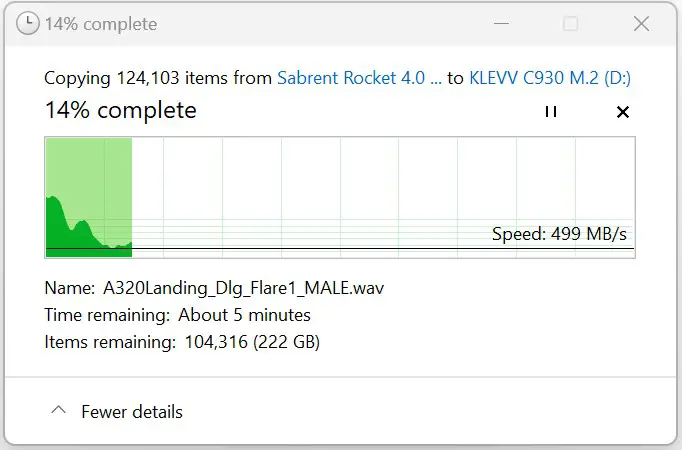

Moving over 300GB of files, it becomes obvious when the smaller files get hit, and when the sustained reads and writes are occurring. This brackets it between half a gig and 2.5GB/s in real-world transfer speed, consistent with other 4th Gen PCIe drives in this bracket. When combined with the price ($83.99 for 1TB and $135.99 for 2TB), this sort of consistent performance within the higher range band makes it a very worthy competitor for the big names out there.
The best news about the C930 is that it’s speedy enough to work on the PlayStation 5. Firing it up, the system immediately detected it and readied it for format. Before it certifies as ready to go it also does a quick benchmark. It handily maxes out the interface on Sony’s console, meaning it’ll deliver gaming goodness to your eyeballs as fast as the system can process it — an added bonus, whether you intend to use this on PC or console.
Like several other drive manufacturers, KLEVV has seen fit to include a copy of Acronis True Image HD in the box as a complementary method of migrating your data. I’ve found Acronis to be fairly easy to use, even for the layperson, so it’s a valuable tool and not just a frivolous pack-in. Unfortunately, Acronis has moved to a subscription model so the 2018 version (the one included here) is one of the last standalone versions available.
I’m happy to report that both the C910 and C930 both carry with them a 5 year limited warranty. The C910 comes with a 700 TBW (Terabytes Written) rating, with the C930 hitting slightly higher at 750 TBW for 1TB and 1500 for the 2TB variants.
I find that the best hardware advertises what they can do, and then they simply hit it – no magic, no sleight of hand, and no deception. With both the C910 and the C930, they are very up front on what those drives are capable of delivering, and they do precisely that. While we are at the tail end of the PCIe Gen4x4 race and beginning to move into Gen5 drives, what reviewing these drives tells me is that KLEVV is ready for the next step. I can’t wait to see what they do next.
KLEVV C910 NVMe Drive
Excellent
Hardly newcomers, but just starting to scratch the surface in the US, KLEVV delivers high quality drives in the C910 and C930, and at prices that are highly competitive. The hardware delivers on its promises and opens the door for some competition against the big boys.
Pros
- Highly competitive pricing for both drives
- Delivers promised speeds across a variety of file sizes
- Included optional heat sinks are an added bonus
- Speedy enough for the PlayStation 5
- 5 year warranty on both drives
Cons
- C910 is DRAMless, which may impact some workloads
- Will need more time to exercise warranties and support to build confidence in the US
